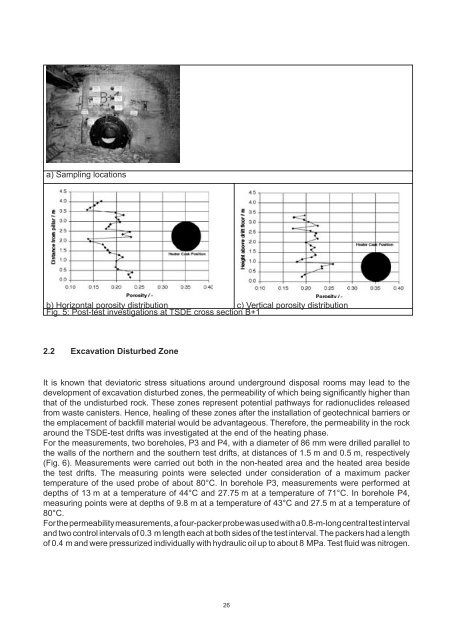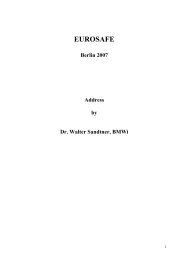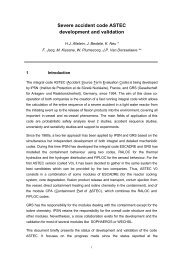Final Results of the BAMBUS II Project - Eurosafe Forum
Final Results of the BAMBUS II Project - Eurosafe Forum
Final Results of the BAMBUS II Project - Eurosafe Forum
Create successful ePaper yourself
Turn your PDF publications into a flip-book with our unique Google optimized e-Paper software.
a) Sampling locations<br />
b) Horizontal porosity distribution c) Vertical porosity distribution<br />
Fig. 5: Post-test investigations at TSDE cross section B+1<br />
2.2 Excavation Disturbed Zone<br />
It is known that deviatoric stress situations around underground disposal rooms may lead to <strong>the</strong><br />
development <strong>of</strong> excavation disturbed zones, <strong>the</strong> permeability <strong>of</strong> which being significantly higher than<br />
that <strong>of</strong> <strong>the</strong> undisturbed rock. These zones represent potential pathways for radionuclides released<br />
from waste canisters. Hence, healing <strong>of</strong> <strong>the</strong>se zones after <strong>the</strong> installation <strong>of</strong> geotechnical barriers or<br />
<strong>the</strong> emplacement <strong>of</strong> backfill material would be advantageous. Therefore, <strong>the</strong> permeability in <strong>the</strong> rock<br />
around <strong>the</strong> TSDE-test drifts was investigated at <strong>the</strong> end <strong>of</strong> <strong>the</strong> heating phase.<br />
For <strong>the</strong> measurements, two boreholes, P3 and P4, with a diameter <strong>of</strong> 86 mm were drilled parallel to<br />
<strong>the</strong> walls <strong>of</strong> <strong>the</strong> nor<strong>the</strong>rn and <strong>the</strong> sou<strong>the</strong>rn test drifts, at distances <strong>of</strong> 1.5 m and 0.5 m, respectively<br />
(Fig. 6). Measurements were carried out both in <strong>the</strong> non-heated area and <strong>the</strong> heated area beside<br />
<strong>the</strong> test drifts. The measuring points were selected under consideration <strong>of</strong> a maximum packer<br />
temperature <strong>of</strong> <strong>the</strong> used probe <strong>of</strong> about 80°C. In borehole P3, measurements were performed at<br />
depths <strong>of</strong> 13 m at a temperature <strong>of</strong> 44°C and 27.75 m at a temperature <strong>of</strong> 71°C. In borehole P4,<br />
measuring points were at depths <strong>of</strong> 9.8 m at a temperature <strong>of</strong> 43°C and 27.5 m at a temperature <strong>of</strong><br />
80°C.<br />
For <strong>the</strong> permeability measurements, a four-packer probe was used with a 0.8-m-long central test interval<br />
and two control intervals <strong>of</strong> 0.3 m length each at both sides <strong>of</strong> <strong>the</strong> test interval. The packers had a length<br />
<strong>of</strong> 0.4 m and were pressurized individually with hydraulic oil up to about 8 MPa. Test fluid was nitrogen.<br />
26





